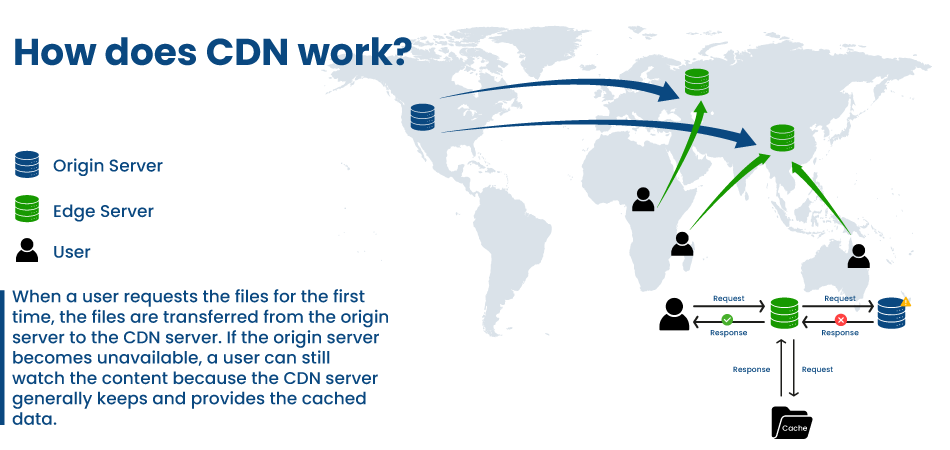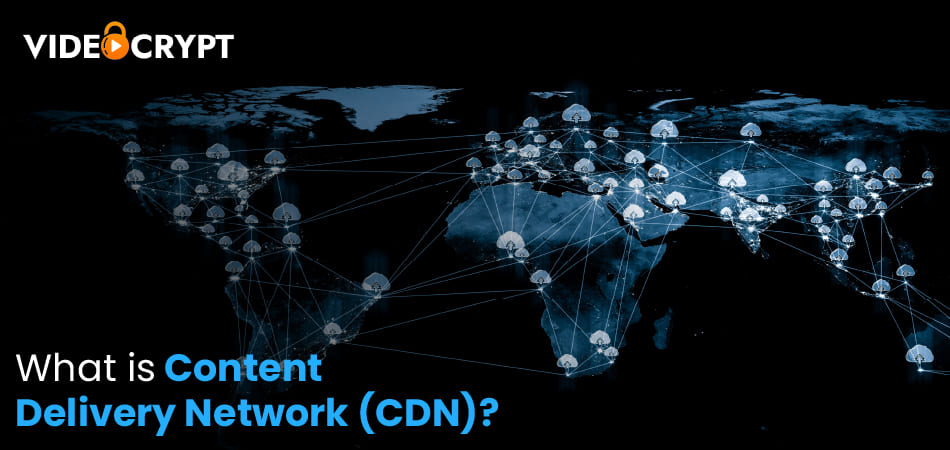In 2023, the worldwide content delivery market was valued at $21.36 billion. It is expected to increase by 17.7% each year from 2024 to 2030. Businesses need to update their operations because of the constant changes in the tech landscape. To stay competitive, businesses must leverage content delivery network technology to satisfy consumers’ demands.
Table of Contents
ToggleWhat is CDN?
CDN (Content Delivery Network) is a network of interconnected servers that accelerate the delivery of media content. The birth of it is meant to enhance media content delivery which has evolved through four generations. That improved static content delivery in the 1990s to exploring blockchain in the present day. It resolves the issue of latency which becomes an annoyance when a user requests to access media content. Also, it takes more than the required time to appear on the user’s device.
Primarily, this delay is due to the physical distance between the hosting server and the user device. To solve this issue, a robust content delivery network is useful by catching content closer to the end user.
Let’s take a closer look at the key points of ideal CDNs –
- Geographical Load Balancing- To distribute network traffic across multiple content delivery networks, CDN load balancing plays an important role. It reroutes the traffic to the other active CDN increasing the reliability.
- Caching- Caching stores files in the nearest CDN server for quick access by the user when needed. It reduces the load on the origin server and improves the performance of the system.
- Flexible Content Broadcasting- CDN accelerates the delivery of static content like a web page and image. But can also handle dynamic content that frequently changes.
Now, that we have explored what is content delivery network. Let’s look at how CDN works through the information given below.
HOW CDN WORKS?

A CDN is a three-part system:
- Origin servers (content creators)- This is where it holds the original file and content updates occur here. They can be owned by the content provider or hosted on cloud platforms.
- Edge servers (content distributors)- Cache content worldwide for faster delivery. Located in multiple points of presence (PoPs), they serve nearby users with copied content from origin servers.
- DNS servers (traffic managers)- Guides users to the closest copy. They keep track of server IP addresses and route user requests to the most efficient edge server.
CDNs have origin, edge, and DNS servers. These servers work together to improve content delivery. CDNs use servers to distribute content efficiently. This results in faster loading times and a smooth user experience globally.
BENEFITS OF CDNs
Numerous advantages can transform the way businesses operate:
- Improve reliability: Allows uninterrupted services to users by tackling problems like server downtime or the network becoming congested.
- Boost page speed and web page performance: Help businesses deliver high-performance website content by reducing file sizes to optimize loading speed.
- Reduce server load: Prevent any single server from being overloaded and speed up the website by caching.
- DDoS protection: Adds another layer of security and efficiently protects against cyber attacks.
- Faster delivery of Content: Provides high-quality content, positively impacting web page performance.
- Cost saving: Reduce expenditure for website operators as less data needs to be transferred from the original server resulting in lower bandwidth cost.
- Improved SEO ranking: Provide a better search engine positioning by improving the loading time and delivering content rapidly.
CDNs IN DIFFERENT INDUSTRIES
The use of CDN networks benefits online businesses and some industries rely heavily on them:
- Education- CDN for e-learning platform offers quick content delivery, upgrades the user experience along with reducing the reliance on expensive server infrastructure, making it economically viable.
- E-commerce- This industry is extremely dependent on CDNs as it help in reducing latency and page speed and ensuring that the product is available all the time which ultimately contributes to profit generation.
- Media and Entertainment- They can deliver media-rich content to users at their location without any network description.
- Online Gaming- Gaming requires consistent speed and performance due to multiple players. CDN sends massive files instantly and speeds up the overall operation with load balancing.
CHALLENGES
CDN also comes with certain challenges. The IT department should be aware of these issues and prevent them by periodically updating the operations. The following are the common problems associated with CDN usage:
- Deployment: Choosing where content comes from and setting it up in many places can be hard. Fix any setup mistakes quickly.
- Content differences by region: Content may be different everywhere. Check content in different areas often and make changes as needed.
- Updating and caching: Keeping content up-to-date and managing new versions can be tricky. Planning is necessary to know how to handle this well.
- Testing: Make sure to thoroughly test the CDN to check it works as you need.
- Security: Protecting content and user data is important. Use good security tools to keep everything safe.
- Staying reliable: Keep the CDN working even if parts of the network fail. Test often to make sure it’s making things more reliable.
THE FUTURE OF CDNs
Undoubtedly, the future of CDNs is bright and has the potential to revolutionize data delivery and management. Currently, it is linked with progress in AI and machine learning. With ongoing progression in digital demand and technological advancements, it will unlock new possibilities and drive the next wave of digital transformation.
CHOOSING THE RIGHT CDNs
Companies aiming to grow need to utilize a quick and reliable content delivery network like Amazon CloudFront. Wondering what CDN in AWS is? It is Amazon CloudFront which globally delivers applications, data, and videos with low latency and high transfer speed.
This global CDN stands out among all other CDNs available as it offers comprehensive solutions. Scalability, competitive pricing, and security are some of its benefits. It is an ideal partner for businesses seeking to enhance their media content delivery.
CONCLUSION
Content delivery network is a critical component of video streaming workflow. As per recent trends in video streaming, it must adapt and innovate with the ever-changing needs. Contact our cloud consultants to learn how we can enhance your streaming services with Amazon CloudFront.
 Offer 1 month Unlimited streaming VOD & Live with VideoCrypt Mobile App For Educational institute and Youtube Creators*
Offer 1 month Unlimited streaming VOD & Live with VideoCrypt Mobile App For Educational institute and Youtube Creators*




